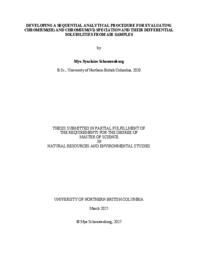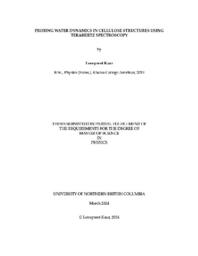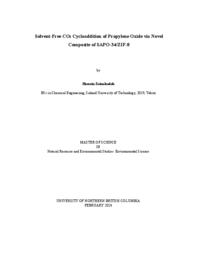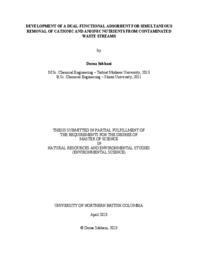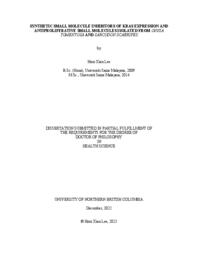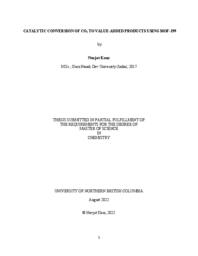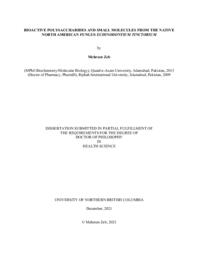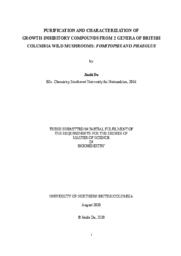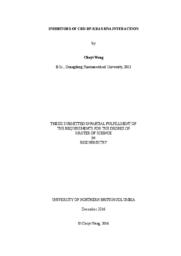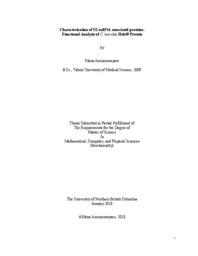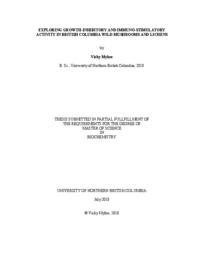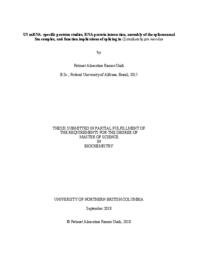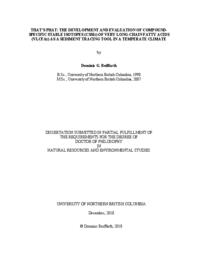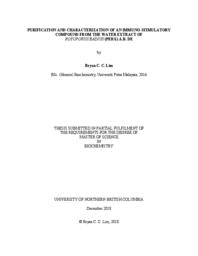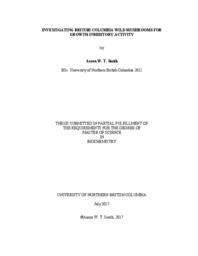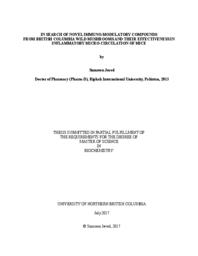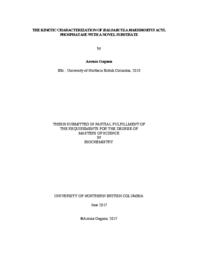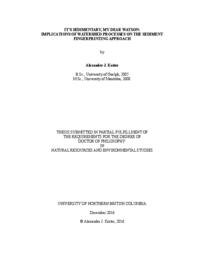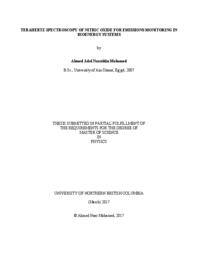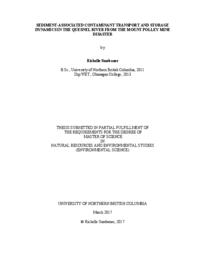Reimer, Kerry
Person Preferred Name
Kerry Reimer
Related Works
Content type
Digital Document
Origin Information
Content type
Digital Document
Description / Synopsis
Terahertz time-domain spectroscopy was used to probe water dynamics in microcrystalline cellulose. In this study, the variation of the dielectric constant of water in microcrystalline cellulose samples with moisture contents between 2.65% and 16.73% was studied. It was found that the dielectric function of water does change with a change in moisture content in microcrystalline cellulose. The dielectric function of water appears to change from what might be expected for bound water towards values that are more consistent with bulk water at higher moisture content. This study is a step forward in the direction of understanding if the dielectric function of water goes from bound to free with a change in moisture content in microcrystalline cellulose. Future work to understand the detailed behavior of this transition is important for wood science and THz application to wood science.
Origin Information
Content type
Digital Document
Description / Synopsis
In this research, ZIF-8/SAPO-34 composites with various wt.% of ZIF-8 and SAPO-34 were prepared and used as catalysts to synthesize cyclic carbonate solventless from CO2 and propylene oxide. Among composites, SAPO-34/ZIF-8 75:25 wt.% (S/Z25) had the highest conversion value of 92.59%, confirmed by 1HNMR analysis. Various physicochemical techniques were used to characterize the optimized composite, including X-ray diffraction (XRD), SEM, FT-IR, and BET. The impact of different reaction parameters such temperature, reaction time, CO2 pressure, and catalyst amount on the catalyst reactivity were studied. The highest conversion value has been obtained at 120 psi, 100 ℃, and 240 min. The conversion value was decreased by 20% when the catalyst loading value was changed from 0.4 to 0.1 g. Additionally, the catalyst's recyclability was confirmed for three runs without any significant changes in conversion. However, it was observed that after five repeated tests of reusability, the conversion percentage value decreased from 92.59% to 88.66%.
Origin Information
Content type
Digital Document
Description / Synopsis
This research focuses on developing environmentally friendly, biodegradable foams as alternatives to traditional petroleum-based materials like polyurethane and expanded polystyrene (EPS). Utilizing pulp and lignin through a cost-effective method, the study optimized factors such as sodium dodecyl sulfate (SDS) concentration, lignin content, and foaming time to achieve desirable mechanical properties and porosity. The box-behnken design identified optimal samples with varied characteristics, including densities from 0.013 g/cm³ to 0.077 g/cm³ and porosities from 95.2% to 99.2%. The introduction of lignin improved foam strength, with compression pressures ranging from 37.5 to 379 kPa. Additionally, the impact of chitosan on porosity, strength, and water resistance was examined. Incorporating 20 wt.% of chitosan enhanced strength by 4% and reduced water absorption by 60%. Over three months, the biodegradable foams displayed significant degradation, introducing them as sustainable alternatives to EPS for diverse applications like packaging.
Origin Information
Content type
Digital Document
Description / Synopsis
Acetylcholinesterase is a hydrolase enzyme known for its major role in neurotransmission regulation by breaking down the neurotransmitter acetylcholine at the synapse after every electrochemical signal is successfully relayed between two adjacent neurons. In a healthy human brain, it retains itself on the extracellular surface of neurons, concordantly paints up an artistic beautiful web of an intricate neural network upon staining. However, in an aging human brain experiencing neurodegeneration, the network collapses into plaques that are neurotoxic to the brain. At the center of these individual plaques are heavily aggregated amyloid-beta peptides and fibers enveloping the neurons. This is most often one of the specific traits of Alzheimer’s and Parkinson’s disease, two most common neurodegenerative diseases. Many studies have provided experimental evidences of stable co-localization and fiber growth promotion existing between the amyloid-beta peptides and acetylcholinesterase. Nevertheless, the specific chemistry and mechanism of how the relationship between the amyloid-beta peptides and acetylcholinesterase is formed and maintained, still remains tentative to date. Most neurodegenerative diseases remain incurable, and most of the available medical treatments focus on alleviating the symptoms and mitigating the disease progression, for instance through the use of acetylcholinesterase inhibitors. But with drawbacks related to treatment effectiveness and undesirable side effects of the current available acetylcholinesterase inhibitors, the continued search for more effective acetylcholinesterase inhibitors has never ceased. The objectives of this in vitro study were to examine four small molecules and twenty-one mushroom extracts for their ability to inhibit acetylcholinesterase activity. To perform the screen, an enzyme assay using Ellman’s reagent DTNB was used. The assay utilizes thiocholine produced from the hydrolysis of acetylthiocholine by acetylcholinesterase to reduce DTNB into TNB2-, a colorimetric product that can be used to monitor the changes in the acetylcholinesterase activity level in the presence or absence of inhibitors. Using the established acetylcholinesterase assay, none of the four small molecules showed any inhibitory effect on acetylcholinesterase activity. On the contrary, eight of the mushroom extracts were found to inhibit the acetylcholinesterase activity. These eight extracts were prepared from five mushroom species that have not been extensively researched nor reported for acetylcholinesterase inhibition. Surprisingly, for the remaining thirteen mushroom extracts that did not show inhibition, they were found to enhance the acetylcholinesterase activity. Albeit the unexpected irrelevance to the focus of the study, these thirteen extracts could be useful as biological tools in the general research of regeneration, as acetylcholinesterase has been reported to act as a mediator promoting cell proliferation and regeneration.
Origin Information
Content type
Digital Document
Description / Synopsis
This work investigated the potential of various natural, modified, and synthetic adsorbent materials for the removal of both cationic (e.g., NH4+) and anionic (e.g., PO43-) nutrients from contaminated waste streams. Among all the studied adsorbents, a commercially available synthetic adsorbent, namely Umix, with 101.6 mg total-P/g, and natural clinoptilolite (NZ) with 17.9 mg total-N/g adsorption capacities demonstrated the best performances in capturing phosphorous-P and nitrogen-N species from aqueous solutions. Zirconium-modified clay (ZrC) also showed a high capacity in adsorbing P species, and eventually, two adsorbent mixtures, including ‘ZrC+NZ’ and ‘Umix+NZ’ were selected for exploring the simultaneous removal of N and P species from bisolute solutions. The effect of various operational parameters, including adsorbent dosage, solution pH, initial nutrient concentrations, and contact time were studied. In an optimum adsorbent (g): solution (ml) loading ratio of 1:300 for ZrC and Umix, and 1:60 for NZ, with 24 h contact time, and using a synthetic NH4-PO4 solution with concentration and pH similar to the targeted wastewater (i.e., dairy farm wastewater), we could achieve 96% total-P and 26% NH4-N removals using ‘ZrC+NZ’, and 94% total-P and 29% NH4-N removals using ‘Umix+NZ’. The pseudosecond-order kinetic model best fitted with experimental data, indicating that chemisorption was the predominant mechanism in bi-solute adsorption processes. A cross-linking reaction between sodium alginate and barium chloride fabricated granules of the powdered adsorbent mixtures. Applying 0.5 g of each of the ‘ZrC/NZ’ and ‘Umix/NZ’ granules in 30 mL of dairy farm wastewater resulted in 20% and 60% total-P and 1.3% and 13% NH4-N removals, respectively. The obtained results showed that the developed granules could be used as dual-functional adsorbent materials to remove cationic and anionic nutrients from contaminated waste streams.
Origin Information
Content type
Digital Document
Description / Synopsis
Small molecules, including synthetic and those isolated from natural products, are important classes of compounds with broad utility, including drugs. The objectives of this dissertation were (i) to synthesize, purify, and characterize novel small molecule inhibitors on KRAS expression level; (ii) to purify and characterize antiproliferative small molecules from Onnia tomentosa and Sarcodon Scabripes. The first part of this Ph.D. dissertation focuses on synthesizing dispiropyrrolidizine derivatives with potential KRAS protein expression inhibitory activity. At the outset of this study, compound UNBC 152, which turned out to be a mixture of compounds, was found to possess bioactivities including antiproliferative activity and the ability to inhibit KRAS expression. This study aimed to synthesize UNBC 152 and resolve the compound-activity ambiguity. The investigation on UNBC 152 led to the isolation of two novel regioisomers, 6 and 7. Regioisomers 6 and 7 were synthesized using a one-pot three-component 1,3-dipolar cycloaddition reaction. They were purified using recrystallization method and their structures were determined by FTIR, ESI-LRMS, NMR, and X-ray crystallography. Regioisomers 6 and 7 showed the ability to inhibit KRAS protein expression. Over the past several decades, researchers have isolated many useful medicinal compounds from mushrooms. Medicinal mushrooms with validated anticancer properties in animals have been found and this has encouraged further exploration of fungal metabolites with antiproliferative activity. The second part of this Ph.D. dissertation focuses on isolating antiproliferative small molecules from two species of mushrooms native to British Columbia (BC). Chapters 3 and 4 described the use of antiproliferative activity-guided approach that led to the isolation and structural elucidation of small molecules from O. tomentosa and S. scabripes native to Northern BC. The ethanolic extracts of O. tomentosa and S. scabripes were purified using phase separation, Sephadex LH-20, and HPLC-based fractionation. The final structure of the small molecules was determined by ESI-LRMS, ESI-HRMS/MS, and NMR. Fatty acids (labeled 1.1-1.4 and 2-7) were identified from the ethanolic extract of O. tomentosa, while several p-terphenyl derivatives (1-4) and one phenolic aldehyde (5) were identified from S. scabripes. Amongst the small molecules, oleic acid (7), linoleic acid (6), and linoleic degradation products from O. tomentosa, and compounds 1-5 from S. scabripes showed antiproliferative activity against HeLa cervical cancer cells.
Origin Information
Content type
Digital Document
Description / Synopsis
With the increase in carbon dioxide emissions into the environment, there is an increased need to capture carbon dioxide (CO2). One method of removal of CO2 that has been receiving more attention is its conversion to useful chemicals. Metal organic frameworks (MOFs) are promising candidates in catalysis because of their remarkable properties such as great surface area, high stability, active sites, porosity, tunability and affinity for CO2. In this study metal organic framework i.e., MOF-199, developed by solvothermal and evaporation-induced self-assembly (EISA) techniques, was used to catalyze the reaction between CO2 and epoxides such as propylene oxide (EP1), styrene oxide (EP2), epichlorohydrin (EP3), and 1,2-epoxybutane (EP4). The corresponding carbonates are obtained by using tetrabutylammonium bromide (TBAB) as a co-catalyst. The synthesized MOF-199 was characterized by X-ray diffraction, Fourier transform infrared spectroscopy, thermal gravimetric analysis, scanning electron microscopy, and Brunauer-Emmett-Teller analysis. More than 65% conversion of epoxides (EP1, EP2, EP3, and EP4) to their corresponding carbonates were obtained under mild reaction conditions (100°C and 70 psi) over the synthesized MOF-199 catalysts (1S, 2E, 3E, and 4E), and co-catalyst (TBAB). The percentage yields of cyclic carbonates were determined by using 1H-NMR spectroscopy. The synthesized MOF catalysts demonstrated the high catalytic activity for the chemical fixation of CO2 to cyclic carbonates at mild reaction conditions.
Origin Information
Content type
Digital Document
Description / Synopsis
As more attention is focused on the emission of CO2 into the environment, CO2 produced by industrial sources such as fossil-fuel power plants can be used as a potential source for the manufacturing of useful chemicals. Carbonate synthesis is a general approach for the conversion of CO2 using epoxides. The reaction of CO2 with epoxides to produce cyclic carbonates requires a catalyst with a high surface area, Lewis active sites, and an affinity for CO2. In this study, copper-based MOF catalysts (MOF-199, Cu-BDC, NH2-Cu-BDC) were synthesized by solvothermal method under mild reaction conditions. These catalysts were characterized by powdered X-ray diffraction, Fourier-Transform infrared spectroscopy, thermal gravimetric analysis, scanning electron microscope, and Brunauer-Emmett-Teller analysis. MOF-199 was subsequently used as a heterogeneous catalyst to catalyze the reaction of CO2 with epoxides to produce value-added cyclic carbonates. More than 65% conversion of epoxides (E1-E4) to the corresponding cyclic carbonates was observed using MOF-199 catalysts (C1, C2-S6, C2-S4, and C2-S6) and TBAB under mild reaction conditions. The conversion to cyclic carbonates was analyzed using 1H-NMR Spectroscopy.
Origin Information
Content type
Digital Document
Description / Synopsis
Mushrooms, the fruiting bodies of fungi, are known to be powerful sources of nutraceuticals and pharmaceuticals but there are limited studies focusing on exploring the medicinal value of mushrooms native to North America. Here, I describe the isolation of two novel bioactive polysaccharides from the aqueous extracts of the fungus Echinodontium tinctorium: an immunostimulatory complex polysaccharide (EtISPFa) of 1354 kDa, and a growth-inhibitory β-glucan of 275 kDa. In addition, six small molecules including a phenol derivative, a new diphenylmethane derivative and three lanostane-type triterpenes were isolated from the organic extracts of E. tinctorium. The molar mass of these isolated small molecules (labelled 1-6) was determined to be 124, 260, 506, 498, 496, and 440 g/mol respectively. Phase separation, Sephadex LH-20 size exclusion, Sephadex DEAE ion exchange chromatography, Sephacryl S-500 HR size exclusion, silica column chromatography, and HPLC were used for bioactivity-guided purification. Chemical structures and linkages of EtISPFa and EtGIPL1a polysaccharides were determined by gas chromatography mass spectrometry (GCMS) and nuclear magnetic resonance (NMR). Final structures of small molecules were determined by Fourier transform infrared spectroscopy (FTIR), electrospray ionization mass spectrometry (ESI-MS), NMR, and X-ray crystallography. Immuno-stimulatory activity of EtISPFa was assessed by immunoassay in Raw 264.7 murine macrophage cells and growth-inhibitory activity of EtGIPL1a and small molecules were assessed by MTT growth-inhibitory assay in cancer cell lines. The mechanism of growth inhibition was assessed via apoptosis and cell cycle assays. EtISPFa stimulated the immune response by inducing TNF-α and other inflammatory cytokines in murine macrophage cells. In contrast, EtGIPL1a showed promising anti-proliferative activity against U251 glioblastoma cells and on ten other cancer cell lines. EtGIPL1a induced apoptosis in U251 cells with an increased cleaved caspase-3 apoptotic marker and significant DNA fragmentation in cell cycle analysis. Amongst the small molecules, compounds (2), (4) and (5) caused growth-inhibition in U251 cells; compound (4) also showed promising effects on multiple other cancer cell lines; all its bioactivities are reported here for the first time. The crystal structures of compounds (2), (4) and (5) have also been reported for the first time. Molecular targets of (1), (2), (4) and (5) by MolTarPred were predicted and warrants further experimental investigation.
Origin Information
Content type
Digital Document
Description / Synopsis
Modern science is currently working to characterize the beneficial compounds from mushrooms and their potential as pharmaceutical drugs. In this thesis, eight British Columbian wild mushroom collections (3 species), comprising Fomitopsis pinicola, Phaeolus schweinitzii and Phaeolus sp., were screened for growth-inhibitory potential. Out of 28 crude extracts, 15 exhibited strong growth-inhibitory activity. For the Phaeolus sp. collection, liquid-liquid extraction, sizeexclusion chromatography and high-performance liquid chromatograph-mass spectrometry (HPLCMS) were used to purify the growth-inhibitory compound of interest. NMR analyses confirmed its identity as hispidin, a known potent anti-cancer compound. Another compound with a mass to charge ratio of 283.2 in hexane extract of Phaeolus sp. was detected by HPLC-MS. This study provides the foundational work for further isolation of small molecule(s) from the three mushroom species and shed light on the profile of Phaeolus sp. as a source of growth-inhibitory compounds.
Origin Information
Content type
Digital Document
Description / Synopsis
The first part of this thesis investigated the growth-inhibitory and immunomodulatory potential of six wild Canadian mushrooms. Out of 24 crude extracts, six showed strong growth-inhibitory activity, two exhibited strong immuno-stimulatory activity and nine demonstrated potent anti-inflammatory activity. The second part of this thesis involved purification and characterization of growth-inhibitory compounds from Albatrellus flettii. Liquid-liquid extraction, Sephadex LH-20 and HPLC-Mass Spectrometry (HPLC-MS) were used to purify the three compounds of interest. NMR analyses confirmed their identity as grifolin, neogrifolin and confluentin. Grifolin and neogrifolin inhibited IMP1-KRas RNA interaction as demonstrated using an in-vitro fluorescent polarization assay. The three compounds suppressed KRas expression in SW480 and HT-29 human colon cancer cells. Confluentin, shown for the first time, to induce apoptosis and arrest cell cycle in SW480 cells. The third part of this thesis involved the development of methods to purify growth-inhibitory compounds from Sarcodon scabripes. HPLC-MS detected some potential novel compounds.
Origin Information
Content type
Digital Document
Description / Synopsis
KRAS-driven cancers are notoriously difficult to treat due to poor pharmacodynamics of downstream inhibitors and resistance to anti-EGFR drugs. IMP-1 is a post-transcriptional regulator of KRAS mRNA. As a novel therapeutic approach, the targeting of the IMP-1-KRAS mRNA complex with a spiropyrrolizidine derivative (UNBC152), was studied. LC-MS analysis of UNBC152 indicated presence of impurities. The purpose of this study was to synthesize UNBC152 and determine the responsible bioactive molecule within the impurities. LC-MS and TLC suggested the presence of a bioactive [3+3] cycloaddition side product (SPOPP) in UNBC152. SPOPP suppressed KRAS expression in human colorectal cancer cells. Fluorescence polarization determined that SPOPP did not impact the IMP-1-KRAS mRNA interaction. SPOPP induced G2/M cell cycle arrest as shown by flow cytometry. MTT assay confirmed the SPOPP-induced growth inhibition in SW480 (IC50 = 4.17 μM) and HT29 (IC50 = 6.76 μM). These findings represent a first reporting on the bioactivity of SPOPP.
Origin Information
Content type
Digital Document
Origin Information
Content type
Digital Document
Origin Information
Content type
Digital Document
Origin Information
Content type
Digital Document
Origin Information
Content type
Digital Document
Origin Information
Content type
Digital Document
Origin Information
Content type
Digital Document
Origin Information
Content type
Digital Document
Origin Information
Content type
Digital Document
Origin Information
Content type
Digital Document
Origin Information
Content type
Digital Document
Origin Information

